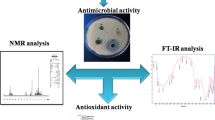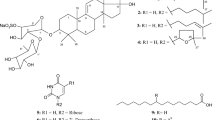Abstract
Peptide fractions extracted from Flathead by-products were evaluated for in vitro free radical scavenging and cancer cell cytotoxic activities. The degree of hydrolysis (DH), presence of protease and molecular weight (MW) influenced the 2,2-diphenyl-1-pycryl-hydrazyl (DPPH) and 2,2-azino-bis-3-ethylbenzothiazoline-6-sulphonic (ABTS) radical scavenging activities (RSA) of Flathead peptide fraction. Low MW peptides (<3 kDa), obtained from overnight incubation with added an exogenous protease, significantly inhibited free radicals and showed the highest RSA of 94.03 and 82.89 % against DPPH· and ABTS·+, respectively. The presence of bioactive peptides during H2O2 exposure increased viability of T4056 normal cells. Furthermore, peptide fractions <3 kDa inhibited the growth of HT-29 colon cancer cells up to 91.04 %, although the activity was found to be non-selective. Further purification revealed a novel peptide, Met-Gly-Pro-Pro-Gly-Leu-Ala-Gly-Ala-Pro-Gly-Glu-Ala-Gly-Arg, with RSA properties. These results indicated that peptides extracted from Flathead by-products have a potential to be used as natural antioxidants and/or chemo-protective agents.






Similar content being viewed by others
Abbreviations
- ABTS:
-
2,2-Azino-bis-3-ethylbenzothiazoline-6-sulphonic
- AFP:
-
Acid fungal protease
- DH:
-
Degree of hydrolysis
- DPPH:
-
2,2-Diphenyl-1-pycryl-hydrazyl
- FPH:
-
Fish protein hydrolysate
- MW:
-
Molecular weight
- MWCO:
-
Molecular weight cut off
- ON:
-
Incubated overnight without the addition of AFP
- ONE:
-
Incubated overnight with the addition of AFP
- ROS:
-
Reactive oxygen species
- RSA:
-
Radical scavenging activity
- UF:
-
Unfractionated
- UH:
-
Unhydrolysed/Control
References
Je JY, Park PJ, Kim SK (2005) Antioxidant activity of a peptide isolated from Alaska pollack (Theragra chalcogramma) frame protein hydrolysate. Food Res Int 38(1):45–50
Perchellet J, Perchellet E, Gali H, Gao X (1995) Oxidant stress and multistage carcinogenesis. In: Mukhtar H (ed) Skin cancer: mechanisms and human relevance. CRC Press, Boca Raton, pp 145–180
Nelson KK, Ranganathan AC, Mansouri J, Rodriguez AM, Providence KM, Rutter JL, Pumiglia K, Bennett JA, Melendez JA (2003) Elevated sod2 activity augments matrix metalloproteinase expression: evidence for the involvement of endogenous hydrogen peroxide in regulating metastasis. Clin Cancer Res 9(1):424–432
Jiménez-Estrada M, Velázquez-Contreras C, Garibay-Escobar A, Sierras-Canchola D, Lapizco-Vázquez R, Ortiz-Sandoval C, Burgos-Hernández A, Robles-Zepeda RE (2013) In vitro antioxidant and antiproliferative activities of plants of the ethnopharmacopeia from northwest of Mexico. BMC Complement Altern Med 13(1):12
Bennett L, Logan A, Terefe NS, Singh T, Warner R (2013) Measuring the oxidation potential in foods. In: Bartosz G (ed) Food oxidants and antioxidants. Chemical and functional properties of food components. CRC Press, Boca Raton, pp 47–78
Elias RJ, Kellerby SS, Decker EA (2008) Antioxidant activity of proteins and peptides. Crit Rev Food Sci Nutr 48(5):430–441
Bougatef A, Hajji M, Balti R, Lassoued I, Triki-Ellouz Y, Nasri M (2009) Antioxidant and free radical-scavenging activities of smooth hound (Mustelus mustelus) muscle protein hydrolysates obtained by gastrointestinal proteases. Food Chem 114(4):1198–1205
Nazeer RA, Srividhya TS (2011) Antioxidant peptides from the protein hydrolysates of conus betulinus. Int J Pept Res Ther 17(3):231–237
Alemán A, Pérez-Santín E, Bordenave-Juchereau S, Arnaudin I, Gómez-Guillén MC, Montero P (2011) Squid gelatin hydrolysates with antihypertensive, anticancer and antioxidant activity. Food Res Int 44:1044–1051
Bernardini RD, Harnedy P, Bolton D, Kerry J, O’Neill E, Mullen AM, Hayes M (2011) Antioxidant and antimicrobial peptidic hydrolysates from muscle protein sources and by-products. Food Chem 124:1296–1307
Ryan JT, Ross RP, Bolton D, Fitzgerald GF, Stanton C (2011) Bioactive peptides from muscle sources: meat and fish. Nutrients 3:765–791
Intarasirisawat R, Benjakul S, Visessanguan W, Wu J (2012) Antioxidative and functional properties of protein hydrolysate from defatted skipjack (Katsuwonous pelamis) roe. Food Chem 135(4):3039–3048
Samaranayaka AGP, Li-Chan ECY (2011) Food-derived peptidic antioxidants: a review of their production, assessment, and potential applications. J Funct Foods 3(4):229–254
Barkia A, Bougatef ALI, Khaled HB, Nasri M (2010) Antioxidant activities of sardinelle heads and/or viscera protein hydrolysates prepared by enzymatic treatments. J Food Biochem 34:303–320
Samaranayaka AGP, Li-Chan ECY (2008) Autolysis-assisted production of fish protein hydrolysates with antioxidant properties from Pacific hake (Merluccius productus). Food Chem 107(2):768–776
Pihlanto A, Korhonen H (2003) Bioactive peptides and proteins. In: Taylor SL (ed) Advances in food and nutrition research, vol 47. Academic Press, San Diego, USA, pp 175–276
Muro C, Riera F, Fernández A (2013) Advancements in the fractionation of milk biopeptides by means of membrane processes. Bioact Food Pept Health Dis: 241
Kailola PJ, Williams MJ, Stewart PC, Reichelt RE, McNee A, Grieve C (1993) Australian fisheries resources. Bureau of Resource Sciences, Canberra
Gagnon MM, Holdway DA (2002) EROD activity, serum SDH and PAH biliary metabolites in sand flathead (Platycephalus bassensis) collected in Port Phillip Bay, Australia. Mar Pollut Bull 44(3):230–237
Nurdiani R, Dissanayake M, Street WE, Donkor ON, Singh TK, Vasiljevic T (2016) In vitro study of selected physiological and physicochemical properties of fish protein hydrolysates from 4 Australian fish species. Int Food Res J 23(5)
Nurdiani R, Dissanayake M, Street WE, Donkor ON, Singh TK, Vasiljevic T (2015) Sustainable use of marine resources—turning waste into food ingredients. Int J Food Sci Technol 50(11):2329–2339
Bradford MM (1976) A rapid and sensitive method for the quantitation of microgram quantities of protein utilizing the principle of protein-dye binding. Anal Biochem 72(1):248–254
Hoyle NT, Merritt JH (1994) Quality of fish-protein hyrdolysates from herring (Clupea harengus). J Food Sci 59(1):76–79
AOAC (2005) Official methods of analysis. Association of Official Analytical Chemists, Washington DC
Sah BNP, Vasiljevic T, McKechnie S, Donkor ON (2015) Effect of refrigerated storage on probiotic viability and the production and stability of antimutagenic and antioxidant peptides in yogurt supplemented with pineapple peel. J Dairy Sci 98(9):5905–5916
Ozgen M, Reese RN, Tulio AZ, Scheerens JC, Miller AR (2006) Modified 2,2-Azino-bis-3-ethylbenzothiazoline-6-sulfonic Acid (ABTS) method to measure antioxidant capacity of selected small fruits and comparison to ferric reducing antioxidant power (FRAP) and 2,2′-Diphenyl-1-picrylhydrazyl (DPPH) Methods. J Agric Food Chem 54(4):1151–1157
Zhong S, Ma C, Lin YC, Luo Y (2011) Antioxidant properties of peptide fractions from silver carp (Hypophthalmichthys molitrix) processing by-product protein hydrolysates evaluated by electron spin resonance spectrometry. Food Chem 126(4):1636–1642
Ahmed Z, Donkor O, Street WA, Vasiljevic T (2015) Calpains- and cathepsins-induced myofibrillar changes in post-mortem fish: impact on structural softening and release of bioactive peptides. Trends Food Sci Technol 45(1):130–146
van der Ven C, Gruppen H, de Bont DBA, Voragen AGJ (2002) Optimisation of the angiotensin converting enzyme inhibition by whey protein hydrolysates using response surface methodology. Int Dairy J 12(10):813–820
Yang J-I, Liang W-S, Chow C-J, Siebert KJ (2009) Process for the production of tilapia retorted skin gelatin hydrolysates with optimized antioxidative properties. Process Biochem 44(10):1152–1157
Sabeena Farvin KH, Andersen LL, Nielsen HH, Jacobsen C, Jakobsen G, Johansson I, Jessen F (2014) Antioxidant activity of Cod (Gadus morhua) protein hydrolysates: in vitro assays and evaluation in 5% fish oil-in-water emulsion. Food Chem 149:326–334
Ranathunga S, Rajapakse N, Kim S-K (2006) Purification and characterization of antioxidative peptide derived from muscle of conger eel (Conger myriaster). Eur Food Res Technol 222(3):310–315
Wu H-C, Chen H-M, Shiau C-Y (2003) Free amino acids and peptides as related to antioxidant properties in protein hydrolysates of mackerel (Scomber austriasicus). Food Res Int 36(9–10):949–957
You L, Zhao M, Regenstein JM, Ren J (2010) Purification and identification of antioxidative peptides from loach (Misgurnus anguillicaudatus) protein hydrolysate by consecutive chromatography and electrospray ionization-mass spectrometry. Food Res Int 43(4):1167–1173
Fan J, He J, Zhuang Y, Sun L (2012) Purification and identification of antioxidant peptides from enzymatic hydrolysates of tilapia (Oreochromis niloticus) frame protein. Molecules 17(11):12836–12850
Jia J, Zhou Y, Lu J, Chen A, Li Y, Zheng G (2010) Enzymatic hydrolysis of Alaska pollack (Theragra chalcogramma) skin and antioxidant activity of the resulting hydrolysate. J Sci Food Agric 90(4):635–640
Alemán A, Giménez B, Pérez-Santin E, Gómez-Guillén M, Montero P (2011) Contribution of Leu and Hyp residues to antioxidant and ACE-inhibitory activities of peptide sequences isolated from squid gelatin hydrolysate. Food Chem 125(2):334–341
Cheung IWY, Cheung LKY, Tan NY, Li-Chan ECY (2012) The role of molecular size in antioxidant activity of peptide fractions from Pacific hake (Merluccius productus) hydrolysates. Food Chem 134(3):1297–1306
Huang GR, Zhao J, Jiang JX (2011) Effect of defatting and enzyme type on antioxidative activity of shrimp processing byproducts hydrolysate. Food Sci Biotechnol 20(3):651–657
Raghavan S, Kristinsson HG, Leeuwenburgh C (2008) Radical scavenging and reducing ability of tilapia (Oreochromis niloticus) protein hydrolysates. J Agric Food Chem 56(21):10359–10367
Ren J, Zhao M, Shi J, Wang J, Jiang Y, Cui C, Kakuda Y, Xue SJ (2008) Purification and identification of antioxidant peptides from grass carp muscle hydrolysates by consecutive chromatography and electrospray ionization-mass spectrometry. Food Chem 108(2):727–736
Kong B, Peng X, Xiong YL, Zhao X (2012) Protection of lung fibroblast MRC-5 cells against hydrogen peroxide-induced oxidative damage by 0.1–2.8 kDa antioxidative peptides isolated from whey protein hydrolysate. Food Chem 135(2):540–547
Cheeseman K, Slater T (1993) An introduction to free radical biochemistry. Br Med Bull 49(3):481–493
Liu L-X, Zhang W-H, Jiang H-C (2003) Current treatment for liver metastases from colorectal cancer. World J Gastroenterol 9(2):193–200
Rodrigues EG, Dobroff AS, Taborda CP, Travassos LR (2009) Antifungal and antitumor models of bioactive protective peptides. An Acad Bras Ciênc 81:503–520
Chi C-F, Hu F-Y, Wang B, Li T, Ding G-F (2015) Antioxidant and anticancer peptides from the protein hydrolysate of blood clam (Tegillarca granosa) muscle. J Funct Foods 15:301–313
Hoelder S, Clarke PA, Workman P (2012) Discovery of small molecule cancer drugs: successes, challenges and opportunities. Mol Oncol 6(2):155–176
Batista I (2013) Biological activities of fish-protein hydrolysates. In: Kim SK (ed) Marine proteins and peptides. Wiley, West Sussex, UK, pp 111–138
Ngo D-H, Ryu B, Kim S-K (2014) Active peptides from skate (Okamejei kenojei) skin gelatin diminish angiotensin-I converting enzyme activity and intracellular free radical-mediated oxidation. Food Chem 143:246–255
Mendis E, Rajapakse N, Kim SK (2005) Antioxidant properties of a radical-scavenging peptide purified from enzymatically prepared fish skin gelatin hydrolysate. J Agric Food Chem 53(3):581–587
Chi C-F, Wang B, Wang Y-M, Zhang B, Deng S-G (2015) Isolation and characterization of three antioxidant peptides from protein hydrolysate of bluefin leatherjacket (Navodon septentrionalis) heads. J Funct Foods 12:1–10
Acknowledgments
We are gratefully acknowledged the Indonesian Department of Higher Education (DIKTI) for providing financial support and Barwon Foods, Geelong, for supplying the fish samples. The authors acknowledge with gratitude the assistance of Dr. David Steer for peptide identification.
Author information
Authors and Affiliations
Corresponding author
Ethics declarations
Conflict of interest
The authors declare that they have no conflicts of interest.
Compliance with ethics requirements
This article does not contain any studies with human or animal subjects.
Rights and permissions
About this article
Cite this article
Nurdiani, R., Vasiljevic, T., Yeager, T. et al. Bioactive peptides with radical scavenging and cancer cell cytotoxic activities derived from Flathead (Platycephalus fuscus) by-products. Eur Food Res Technol 243, 627–637 (2017). https://doi.org/10.1007/s00217-016-2776-z
Received:
Revised:
Accepted:
Published:
Issue Date:
DOI: https://doi.org/10.1007/s00217-016-2776-z




